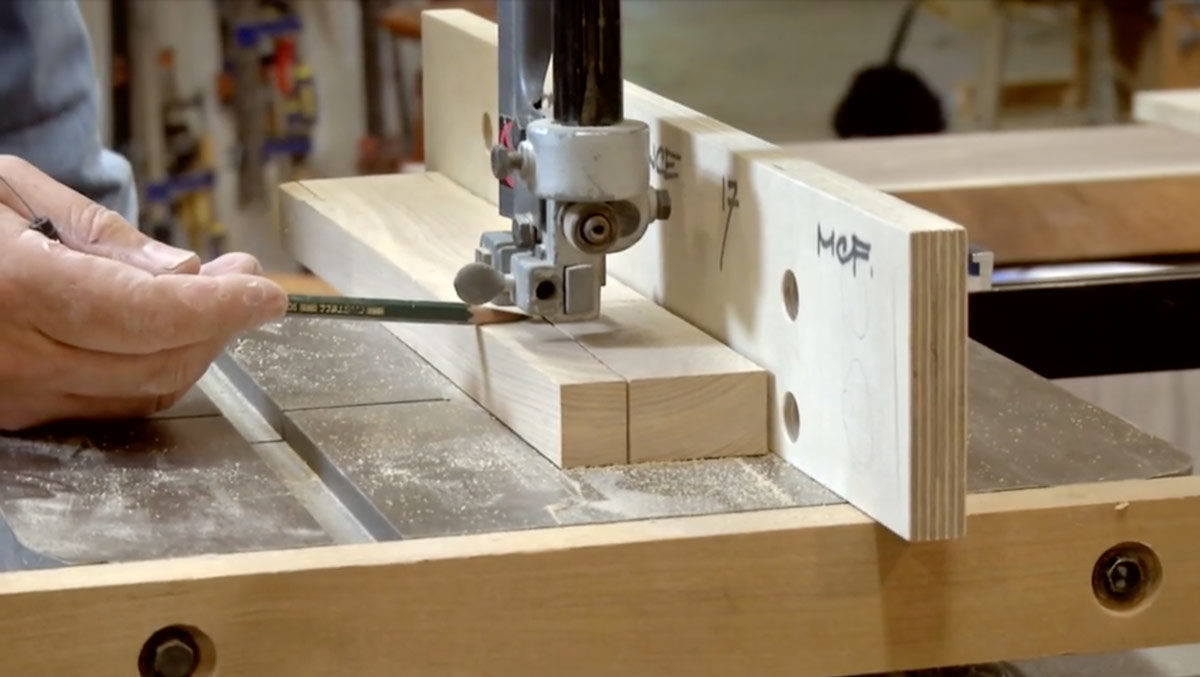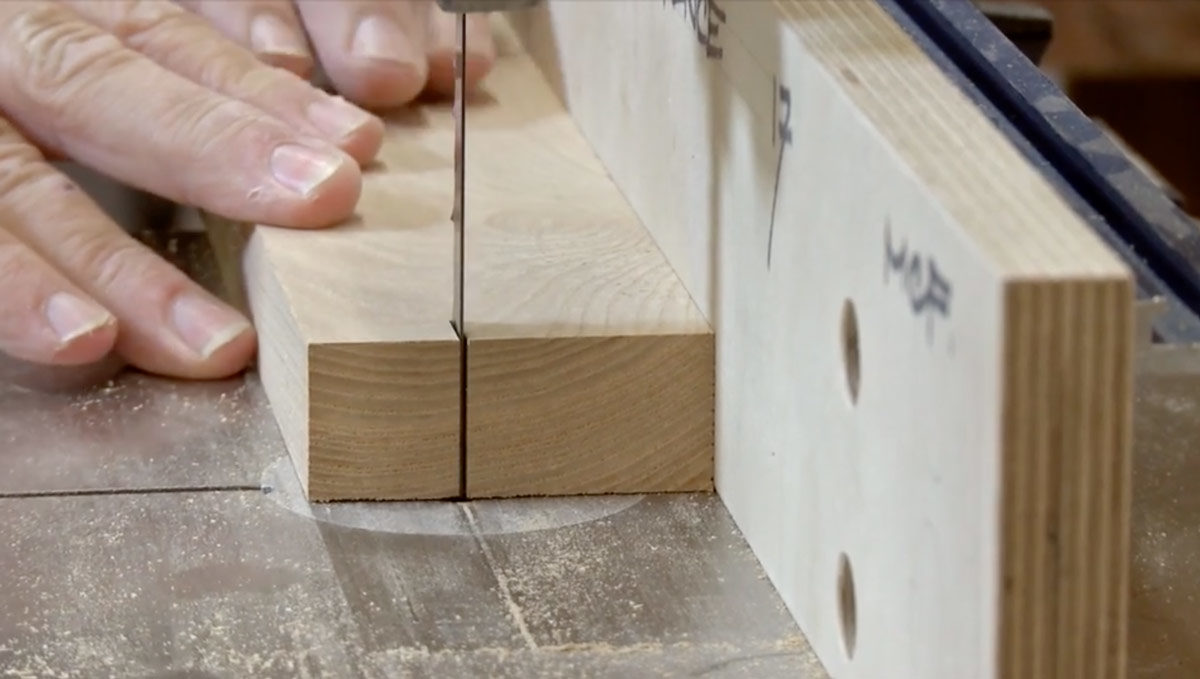How to eliminate drift from bandsaw cuts
A sharp blade isn't the only answer to bandsaw drift. In this video Michael Fortune shows you two fixes to make your saw run true.
The bandsaw is easily one of the most versatile pieces of machinery found in a woodworking shop. It’s also likely the most misunderstood. Michael Fortune has logged countless hours using his shop’s eight bandsaws, and he knows how to get the most out of them.
One problem that many woodworkers face when using a bandsaw that has been poorly set up is drift. Many woodworkers think that there is no actual fix for drift, so they might as well accept it and work around it. Granted, adjusting the fence to compensate for drift will get you a straight cut, but it renders the saw’s miter slot useless, because now the blade isn’t aligned with the miter slot. Your saw came with a miter gauge, you should be able to use it. At the very least, you’re going to want to build some jigs that will use the miter slot as a reference.

In his article, Five Tips for Better Bandsawing, Michael told us his recipe for getting rid of drift:
When I bought my bandsaw in 1974, I set the fence parallel to the miter-gauge slot in the table, and I haven’t had to adjust it since. The reason is that I use the tracking adjustment on the upper bandsaw wheel to align the blade. A nightmare of fence adjustments ensues if each new blade is allowed to track differently.
Simply by keeping the centerline of the blade (regardless of width) in line with the centerline of the upper wheel, I am able to keep the blade aligned correctly at the blade guides.
The relationship between tracking the blade on the centerline of the upper wheel and having the fence aligned parallel to the miter slot should produce a kerf with equal space on either side of the blade.
Much has been made in books and articles of the alignment of the two wheels to each other. In my shop and in my travels to schools around North America, I have never found this to be a problem. Tracking the blade properly on the upper wheel has always been enough, except in the case of a severely damaged bandsaw.
In this video, Michael takes you through the process step by step. From now on, as long as you have a sharp blade, bandsaw drift will be a distant memory. And now that your bandsaw is cutting true to its miter slot, you can use Michael’s jigs for perfect bandsawn dovetails such as those featured in the next issue of Fine Woodworking.

More on FineWoodworking.com:
- Video: How to Move a Bandsaw by Michael Fortune
- Video: Bandsaw Maintenance Tips by Michael Fortune
- Learn to Resaw by Tim Rousseau #253–Mar/Apr 2016 Issue
- Essential Bandsaw Blades by Roland Johnson #252–Jan/Feb 2016 Issue








Comments
Great video and great timing; I just ordered my first "real" bandsaw for my shop. Thanks to Mr. Fortune and FWW for this!
Thanks Michael for sharing your experience and expertise. What a simple and elegant solution to a vexing problem with so many common but errant solutions.
Thanks, I’ve heard alternative views about aligning the back of the blade gullet to the centre line of the upper wheel. The theory being that it reinforces where the cutting edge of the blade should be supported. Any thoughts on this approach?
Such useful information. Thank you so much.
Thank you for sharing your experience of time. In reference to positioning the blade relative to upper wheel center line. Others, Carter in particular recommends the blade gullet should be centered on the wheel center line to optimize tracking of blade and accurate cuts. These two solutions seem to be opposing one another.
I had trouble having adjustment room with the screws loosened on my old Rockwell/Delta 14" Bandsaw I could not get it to be parallel to the fence at the extreme position. I adjusted the wheel tracking and that seems to have fixed it. I would prefer to set it like Michael does as it makes the most sense to me. Is this an indicator that I need new tires on the wheels or something?
Gullet or front of blade?
Mine never tracks perfectly. Bandsaw for freehand. Table saw for fence.
This is the first I have ever heard of aligning the table to the blade and I have watched a lot of videos and read a lot of articles trying to figure out how to get rid of drift for resawing purposes. I plan to try this and if it actually works, Michael will go to the top of my favorite woodworkers list😊.
I would think changing blades (replacement blades or different size) would require a re-check on the drift regardless of centering setups in the past. I'll check out my ShopSmith bandsaw to see if the table is adjustable.
Once the saw is setup once, it never needs adjustment again, even if you change blades.
They only thing that will need adjustment is the guides and tension if you change blade width, I don’t need to change tracking either.
My minimax bandsaw has flat tires, and I keep my blades with the teeth over the edge. This is an issue that seems to have different correct answers based upon the style of the tire. mm's manual states that they have flat tires and so all of you who keep your blades with the teeth over the edge are doing what should be done. the most recent manuals from laguna say that they run crowned tires and that for the most part keep the blade in the center. That is how I normally ran my laguna and I did not see any tire damage or blade kerf issues. Since all of these machines normally less than 1 1/2 " wide rims ( there are a few saws with wider rims ) , when you run wide resaw blades it is not to hard to have the teeth hang over and still have a good amount over the center of the wheel. Bottom line from my research shows that crowned wheels track blades in the center, flat top wheels off the edge, except for less that 1/4 " blades. ref https://sawmillcreek.org/showthread.php?18924-Bandsaw-blade-tracking-on-flat-crowned-tires-wheels/page2
I am like many out there. Always fighting the drift problem. I have tried most suggestions and have not been able to defeat the problem. I have been told to put the gullet of the blade on the center of the wheel not the way it is explained here. I too am interest in your thoughts on this method. I am going to look at my saw to see if moving the table will solve my frustration.
Thanks
Could you also use the miter gauge with wood scrap to make a 90 degree cut and then check to see if in fact it is 90 degrees and make table adjustment till it checks out?
Good idea, gnostrant, I'll try that after Michael's fix. Thanks for it.
When I purchased my 14" 10-326 Rikon bandsaw several years ago I also got a mobile base to move around my shop as needed. I have never had to re-adjust my table because the base came with a handle with wheels attached to a pivot which goes into a hole on the front of the base. This is well worth the money. I also keep my blade centered in the rubber of the top wheel and it tracks beautifully. The video is top notch Michael.
Does anyone what the piece of wood that is bolted to the back of the table is for?
“[Deleted]”
I have drift on my band saw, so thanks, Michael. I'll try your tip to fix it and report back via these comments.
To user-6524153. The Piece of wood bolted to the back of the table you're asking about if I'm thinking of the same piece, is a fence extension. It's longer than the manufactured fence which came with the saw. I hope this comment helps answer your inquiry.
After watching the video again your answer make perfect sense. Thanks for clarifying.
Sorry, but I'll stick to Alex Snodgrass' approach to where to place the bandsaw blade. Especially if you have a wide blade, fish-tailing of a wide blade across the wheel is too dangerous. Check out for more details https://www.youtube.com/watch?v=wGbZqWac0jU&t=2s
I'm a bit confused. Michael aligns the fence with the miter slot, then rotates the table to stop rubbing against one side of the blade. At that point, there's no drift, but the fence is no longer parallel to the miter slot, right?
Log in or create an account to post a comment.
Sign up Log in